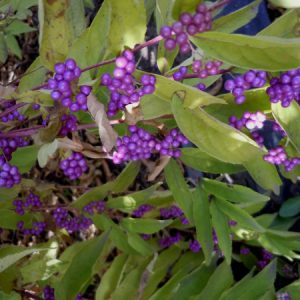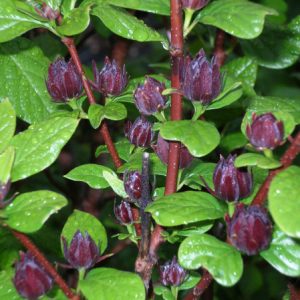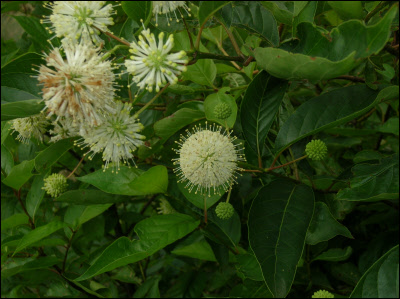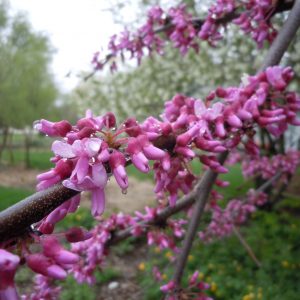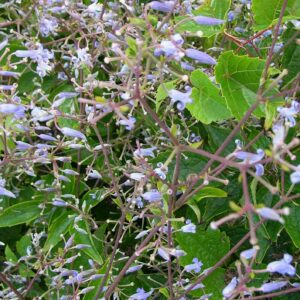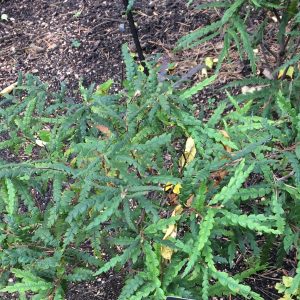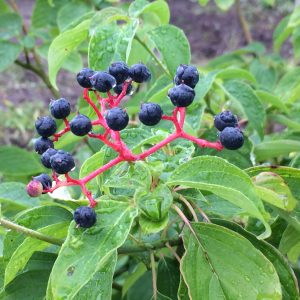Woody Ornamentals
Showing 9–16 of 48 results
-
Callicarpa dichtoma Beautyberry Z 5-8
Tiny pale pink flowers in late summer turn to glossy, purple berries in fall
Tiny pale pink flowers in late summer turn to glossy, royal purple berries in fall. Grow this for the berries.
Can not ship to: Alabama.
Size: 5' x 4'
Care: Full sun to light shade in moist well-drained to well-drained soil. Prune back in early spring nearly to ground.
Native: China and Japan
Awards: Pennsylvania Horticultural Society Gold Medal Plant Award.Collected for gardens before 1800.
**LISTED AS OUT OF STOCK BECAUSE WE DO NOT SHIP THIS ITEM. IT IS AVAILABLE FOR PURCHASE AT OUR RETAIL LOCATION.
-
Calycanthus floridus Carolina allspice, Spicebush, Sweet betties Z 5-9
Fragrant claret flowers in spring through summer.
Fragrant claret flowers in spring through summer with glossy foliage, fast growing
Size: 6-8’ x 4’
Care: Sun to part shade in rich moist to moist well-drained soil
Native: Penn to FL west to ILCherokee used Spicebush, medicinally to remedy sores on children, and bladder ailments, for hives, as an emetic and to improve poor eyesight. They also poisoned wolves with the seed and concocted a perfume. 1st collected in 1726 then introduced by Mark Catesby who illustrated it in 1730. Offered for sale in Bartram Garden’s 1783 Broadside, America’s 1st plant catalog. Grown by Jefferson. Crushed leaves give off the fragrance of strawberries with a hint of apple. The bark smells like cinnamon and was used as a cinnamon substitute. A favorite in antebellum gardens in the SE. Mary Lacey Tandy reports that she loved Carolina allspice from the time when she grew up in Kentucky, “they used to pinch off a few flowers, crush them and put into a hanky which they pinned to their dresses for the smell.” Pressed specimen in Emily Dickinson’s herbarium.
**LISTED AS OUT OF STOCK BECAUSE WE DO NOT SHIP THIS ITEM. IT IS AVAILABLE FOR PURCHASE AT OUR RETAIL LOCATION.
-
Cephalanthus occidentalis Button bush, Honey balls Z 4-10
Perfectly round, white flowers perfume the air in Aug. & Sept. Red leaf stems contrast with green foliage.
Perfectly round, white flowers perfume the air in Aug. & Sept. Red leaf stems contrast with green foliage. Ships only in spring
Size: 6' x 8'
Care: Full sun to part shade in wet to moist well-drained soil
Native: New Brunswick S. to Fla. W. to CA.
Wildlife Value: Important shrub to maintain water quality and for wildlife habitat. Its roots absorb nutrients in water and reduce erosion along water's edges. Flowers attract butterflies. Birds nest in branches.Many medicinal uses for several tribes – Chickasaw, Choctaw, Kiowa, Meskwaki and Seminole, believed to remedy sore eyes, toothaches, dysentery, hemorrhages, headaches, nausea, fevers, constipation, ailments in horses and “wolf ghost sickness.” Rand 1866: “Valuable for blooming at a season when the shrubbery is bare of flowers.” Offered for sale in Bartram Garden’s 1783 Broadside, America’s 1st plant catalog.
**LISTED AS OUT OF STOCK BECAUSE WE DO NOT SHIP THIS ITEM. IT IS AVAILABLE FOR PURCHASE AT OUR RETAIL LOCATION.
-
Cercis canadensis Red bud, Judas tree. Z 4-8
In spring when we need a Dionysian jolt from winter’s hibernation the Red bud’s flowers burst open. Shameless fuchsia buds appear along the tree’s stems, before the leaves unfurl. As spring turns to summer, glossy medium green hearts, the shape of each leaf, replace the buds. Vase shaped, fast growing and blooming as a young tree.
OUT OF STOCK
In spring when we need a Dionysian jolt from winter’s hibernation shameless fuchsia buds appear along the tree’s stems, then Red bud’s flowers burst open before the glossy leaves unfurl.
Size: 20-30’ tall and 25-35’ wide
Care: sun to part shade and moist well drained soil.
Native: between NY northwest to Wisconsin, Florida and southwest to New Mexico. Oklahoma adopted it as its state tree.
Wildlife Value: Spring Azure, Henry’s Elfin & Great Purple Hairstreak butterflies drink flowers’ nectar. Immune to the toxin Juglone from Walnut trees.1st described by French explorer and botanist Joseph Pitton Tournefort in 1700 in Institutiones rei herbariae and he named it Siliquastrum canadense. The tree went through six different names until 1737 when Linnaeus renamed it Cercis canadensis. Collected by Colonial nurseryman John Bartram. (1699-1776) George Washington planted this at Mount Vernon. Cherokee and Delaware steeped Red bud roots and bark in water for cures of fever, stuffiness, whooping cough and vomiting. Cherokee children ate the flowers. French Canadians added them to salads.
**LISTED AS OUT OF STOCK BECAUSE WE DO NOT SHIP THIS ITEM. IT IS AVAILABLE FOR PURCHASE AT OUR RETAIL LOCATION.
-
Clematis stans Japanese clematis Z 4-8
soulful blue starry nodding bells
OUT OF STOCK
Fragrant, smelling of sweet violets, soulful blue starry nodding bells with petals that flip up at the ends (recurved) Blooms August – September. Ships only in spring
Size: 30" x 24"
Care: sun to part shade in moist well-drained soil
Native: JapanStans means “upright” as this is a bush, rather than a vine. (OK, we’ve put this in the vine category and it’s not a vine. But most people think of Clematis as vines and we didn’t want you to miss it.) In Japan called “Kusa-botan.” Collected by Ernest Henry ‘Chinese’ Wilson before 1910.
-
Comptonia peregrina Sweet Fern Z 2-6 SHRUB
Grown for it’s fern like leaves, this small shrub flowers in spring with insignificant yellow flowers followed by brown nutlets. Foliage is fragrant when crushed.
Grown for its fern like leaves, this small shrub flowers in spring with insignificant yellow flowers followed by brown nutlets. Foliage is fragrant when crushed.
LIMITED QUANTITES AVAILABLE. ONE PER CUSTOMER PLEASE.
Size: 2-5’ x 4’ spreading
Care: sun to part shade in moist, well-drained to well-drained soil. Prefers acidic, but will grow in other types of soil as well. Drought and salt tolerant.
Native: Eastern North America, Wisconsin native
Wildlife Value: Attracts bees, butterflies, & birds. Larval host plant for many moths, including Io moth, several Sphinx moth species, and the Anise Swallowtail butterfly. Deer resistant. Nitrogen fixer.Genus name honors Henry Compton (1632-1713), Bishop of London and patron of botany. Many Native Americans (Algonquin, Cherokee, Chippewa, Delaware, Menominee, Potawatomi) used this plant for a wide variety of purposes: crushed leaves inhaled for headache. Leaf infusions for round worms, fevers, beverage, blood purifier, blisters, clear mucus from lungs, bladder inflammation, rash from poison ivy, swelling, flux, stomach cramps, itch. Fragrant leaves- burned or crushed for incense in ceremony, perfume; decoction for childbirth, tonic. Other: sprinkle on medicine to poison enemy, prevent blueberries from spoiling, leaves in fire to make smudge to ward off mosquitoes. Oneida made a tea.
Collected for botany before 1753. Grown at America’s 1st botanic garden, Elgin Botanic Garden 1811.**LISTED AS OUT OF STOCK BECAUSE WE DO NOT SHIP THIS ITEM. IT IS AVAILABLE FOR PURCHASE AT OUR RETAIL LOCATION.
-
Cornus alternifolia Pagoda dogwood Z 4-7
Small tree with horizontal branches in flat tiers & a flat top, like the roof of a pagoda, bearing fragrant white flowers in early summer & blue berries on red stems against maroon leaves in fall.
Small tree with horizontal branches in flat tiers & a flat top, like the roof of a pagoda, bearing fragrant white flowers in early summer & blue berries on red stems against maroon leaves in fall.
Size: 15-30’ x 15-30’
Care: part shade in moist to moist well-drained soil – great understory tree.
Native: Canada to GA, west to MN – WI native
Wildlife Value: Spring azure butterfly caterpillar. 34+ birds (incl. Northern flicker, Woodpeckers & Bluebirds,) eat the fruits.
Awards: Great Plants for Great PlainsAlternifolia means leaves alternating on stem. Cherokee chewed bark for headaches, sore throat, worms, measles & diarrhea. Poltice topically applied on ulcers & a decoction for colds & cough. Collected before 1753. Grown at America’s 1st botanic garden, Elgin Botanic Garden 1811.
**LISTED AS OUT OF STOCK BECAUSE WE DO NOT SHIP THIS ITEM. IT IS AVAILABLE FOR PURCHASE AT OUR RETAIL LOCATION.
-
Corylus americana American Hazelnut, Filbert Z 4-9
In spring, showy male flowers on 2-3" long catkins. Female flowers appear in small, reddish catkins grow into half inch long, egg-shaped edible nuts. Fall color ranges from orange, rose, purplish red, yellow and green.
In spring, showy male flowers on 2-3″ long catkins. Female flowers appear in small, reddish catkins grow into half inch long, egg-shaped edible nuts. Fall color ranges from orange, rose, purplish red, yellow and green.
Size: 10-16’ x 8-1’
Care: sun in any soil
Native: E. North America including Wisconsin
Wildlife Value: Exceptionally high value to wildlife. Pheasant, Quail, Turkey, Grouse, Turkey & Blue Jay and small animals eat the nuts. Pollen source for bees, host to many caterpillars both butterflies and moths. Branches make good nesting sites for songbirds. Black walnut tolerant.Described by Thomas Walter in 1788. Food for several Native American tribes. Medicinal for Cherokee, Iroquois, Menominee, Meskwaki and Ojibwa, to remedy hives, fever, headaches, pain of baby’s teething, hay fever and induce vomiting.
**LISTED AS OUT OF STOCK BECAUSE WE DO NOT SHIP THIS ITEM. IT IS AVAILABLE FOR PURCHASE AT OUR RETAIL LOCATION.

